Early Childhood Studies Assignment 1: Child Observation Report
VerifiedAdded on 2021/04/17
|33
|6546
|38
Homework Assignment
AI Summary
This assignment presents a detailed observation report of a 3-year-old female child in a nursery setting, focusing on her emotional, social, and language development. The report, conducted on two different dates, utilizes time sample and narrative observation methods to capture the child's interactions, behaviors, and responses in various situations. The observations are structured around specific emotional and communication milestones, referencing the EYFS framework. The analysis incorporates relevant theories, including Maslow's hierarchy of needs and Bowlby's attachment theory, to interpret the child's actions and interactions. The report highlights instances where the child demonstrates emotional understanding, social awareness, and language comprehension, along with suggestions for promoting positive behaviors and addressing potential challenges. Ethical considerations, such as obtaining consent and maintaining confidentiality, are also addressed, ensuring the integrity of the observation process. The assignment provides a comprehensive view of child development in a practical setting, offering insights into the application of theoretical concepts.
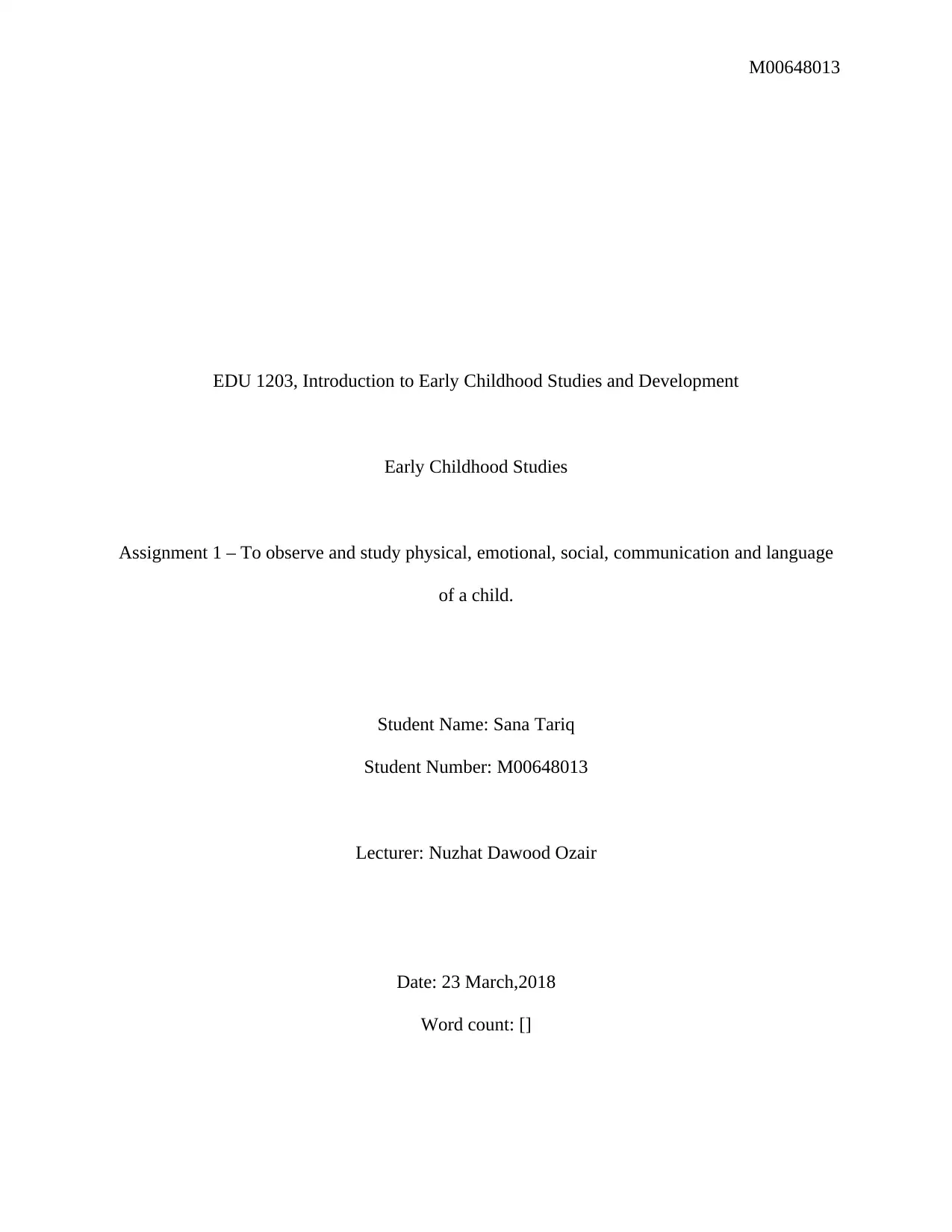
M00648013
EDU 1203, Introduction to Early Childhood Studies and Development
Early Childhood Studies
Assignment 1 – To observe and study physical, emotional, social, communication and language
of a child.
Student Name: Sana Tariq
Student Number: M00648013
Lecturer: Nuzhat Dawood Ozair
Date: 23 March,2018
Word count: []
EDU 1203, Introduction to Early Childhood Studies and Development
Early Childhood Studies
Assignment 1 – To observe and study physical, emotional, social, communication and language
of a child.
Student Name: Sana Tariq
Student Number: M00648013
Lecturer: Nuzhat Dawood Ozair
Date: 23 March,2018
Word count: []
Paraphrase This Document
Need a fresh take? Get an instant paraphrase of this document with our AI Paraphraser
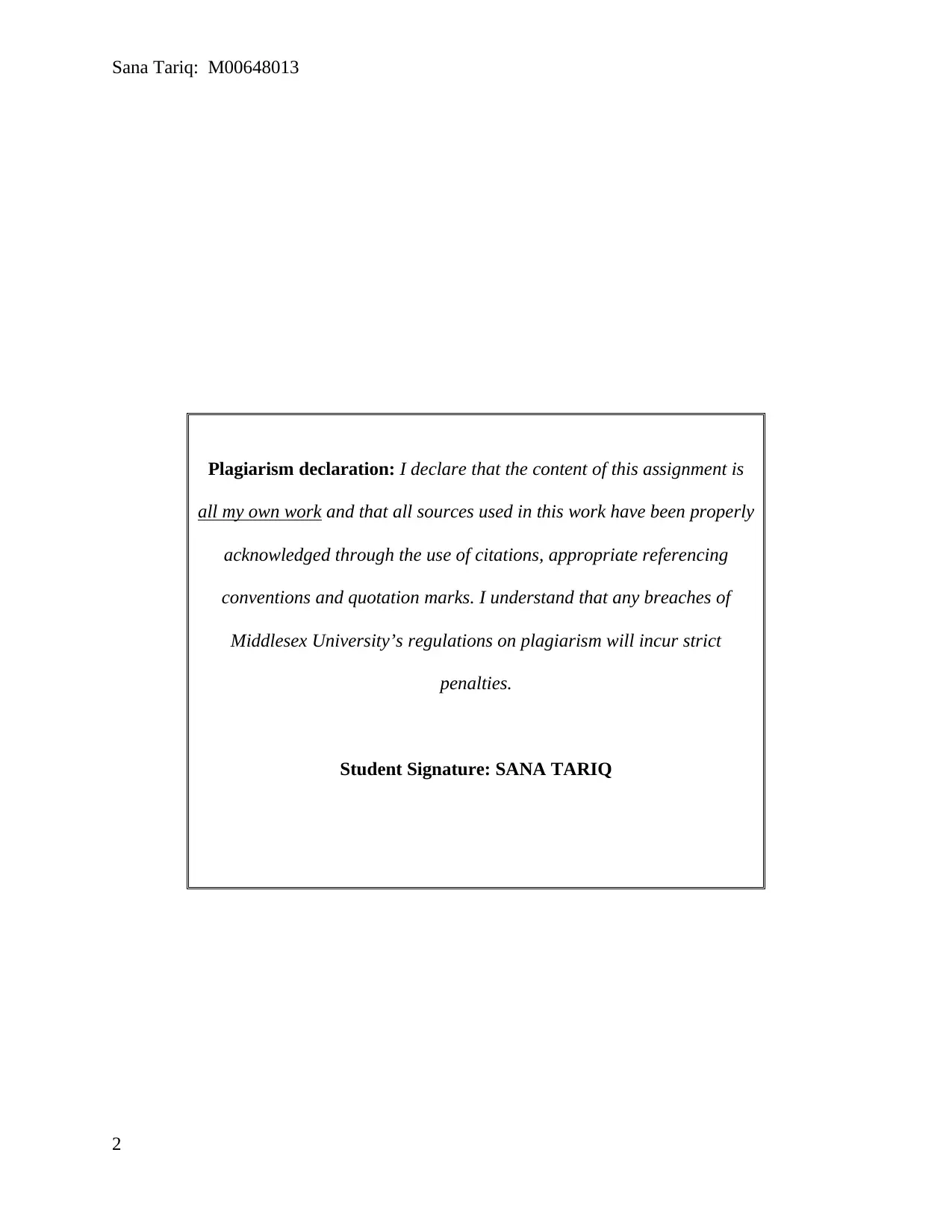
Sana Tariq: M00648013
Plagiarism declaration: I declare that the content of this assignment is
all my own work and that all sources used in this work have been properly
acknowledged through the use of citations, appropriate referencing
conventions and quotation marks. I understand that any breaches of
Middlesex University’s regulations on plagiarism will incur strict
penalties.
Student Signature: SANA TARIQ
2
Plagiarism declaration: I declare that the content of this assignment is
all my own work and that all sources used in this work have been properly
acknowledged through the use of citations, appropriate referencing
conventions and quotation marks. I understand that any breaches of
Middlesex University’s regulations on plagiarism will incur strict
penalties.
Student Signature: SANA TARIQ
2
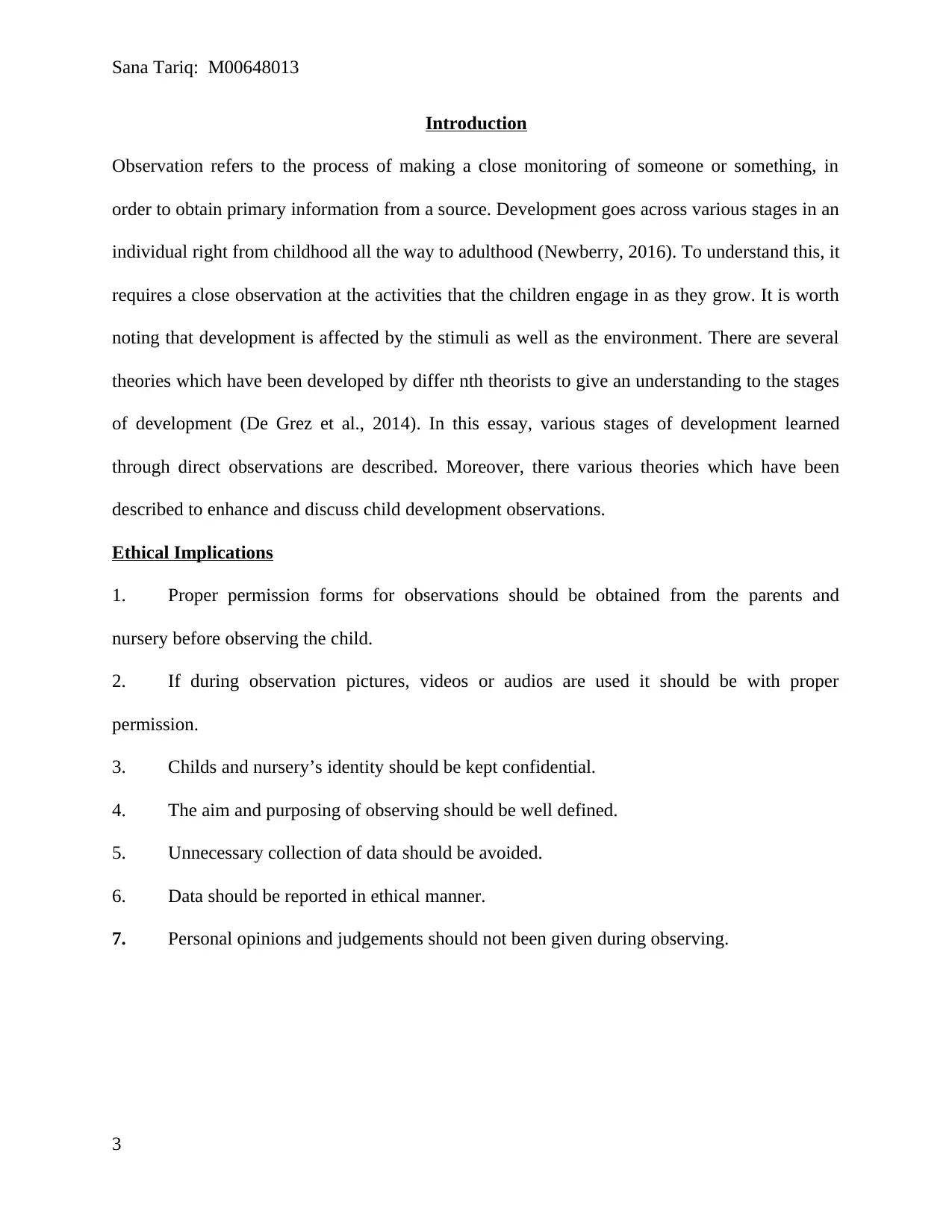
Sana Tariq: M00648013
Introduction
Observation refers to the process of making a close monitoring of someone or something, in
order to obtain primary information from a source. Development goes across various stages in an
individual right from childhood all the way to adulthood (Newberry, 2016). To understand this, it
requires a close observation at the activities that the children engage in as they grow. It is worth
noting that development is affected by the stimuli as well as the environment. There are several
theories which have been developed by differ nth theorists to give an understanding to the stages
of development (De Grez et al., 2014). In this essay, various stages of development learned
through direct observations are described. Moreover, there various theories which have been
described to enhance and discuss child development observations.
Ethical Implications
1. Proper permission forms for observations should be obtained from the parents and
nursery before observing the child.
2. If during observation pictures, videos or audios are used it should be with proper
permission.
3. Childs and nursery’s identity should be kept confidential.
4. The aim and purposing of observing should be well defined.
5. Unnecessary collection of data should be avoided.
6. Data should be reported in ethical manner.
7. Personal opinions and judgements should not been given during observing.
3
Introduction
Observation refers to the process of making a close monitoring of someone or something, in
order to obtain primary information from a source. Development goes across various stages in an
individual right from childhood all the way to adulthood (Newberry, 2016). To understand this, it
requires a close observation at the activities that the children engage in as they grow. It is worth
noting that development is affected by the stimuli as well as the environment. There are several
theories which have been developed by differ nth theorists to give an understanding to the stages
of development (De Grez et al., 2014). In this essay, various stages of development learned
through direct observations are described. Moreover, there various theories which have been
described to enhance and discuss child development observations.
Ethical Implications
1. Proper permission forms for observations should be obtained from the parents and
nursery before observing the child.
2. If during observation pictures, videos or audios are used it should be with proper
permission.
3. Childs and nursery’s identity should be kept confidential.
4. The aim and purposing of observing should be well defined.
5. Unnecessary collection of data should be avoided.
6. Data should be reported in ethical manner.
7. Personal opinions and judgements should not been given during observing.
3
⊘ This is a preview!⊘
Do you want full access?
Subscribe today to unlock all pages.

Trusted by 1+ million students worldwide
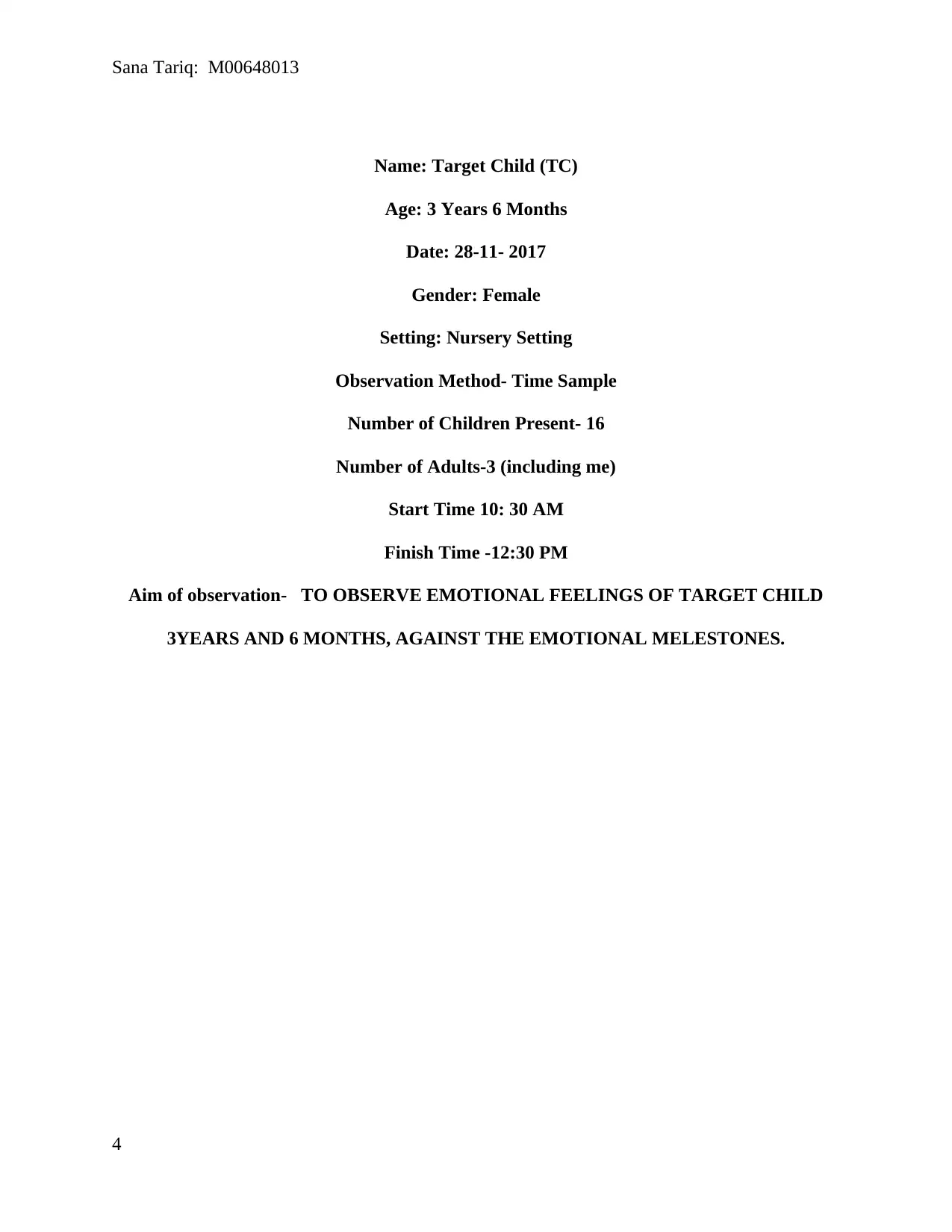
Sana Tariq: M00648013
Name: Target Child (TC)
Age: 3 Years 6 Months
Date: 28-11- 2017
Gender: Female
Setting: Nursery Setting
Observation Method- Time Sample
Number of Children Present- 16
Number of Adults-3 (including me)
Start Time 10: 30 AM
Finish Time -12:30 PM
Aim of observation- TO OBSERVE EMOTIONAL FEELINGS OF TARGET CHILD
3YEARS AND 6 MONTHS, AGAINST THE EMOTIONAL MELESTONES.
4
Name: Target Child (TC)
Age: 3 Years 6 Months
Date: 28-11- 2017
Gender: Female
Setting: Nursery Setting
Observation Method- Time Sample
Number of Children Present- 16
Number of Adults-3 (including me)
Start Time 10: 30 AM
Finish Time -12:30 PM
Aim of observation- TO OBSERVE EMOTIONAL FEELINGS OF TARGET CHILD
3YEARS AND 6 MONTHS, AGAINST THE EMOTIONAL MELESTONES.
4
Paraphrase This Document
Need a fresh take? Get an instant paraphrase of this document with our AI Paraphraser
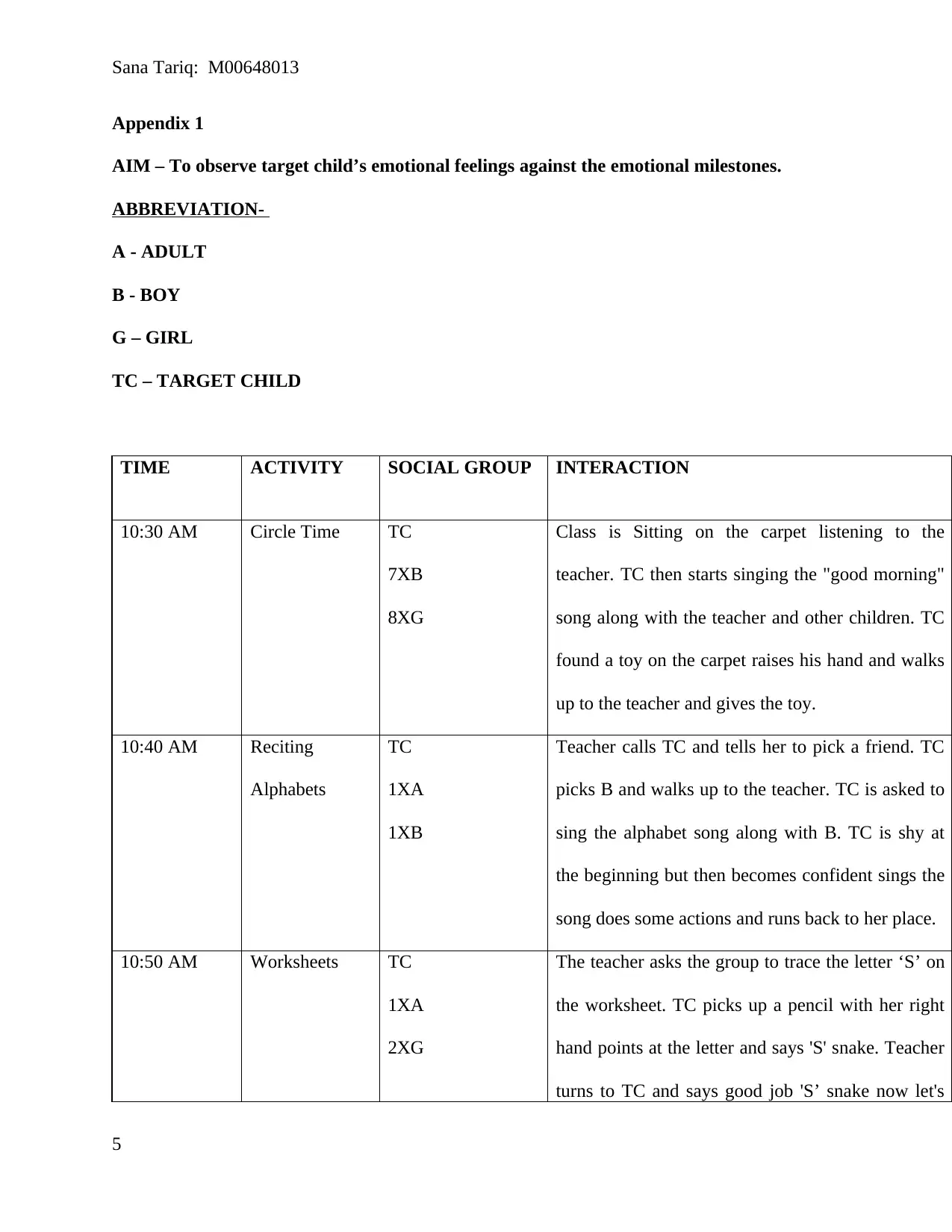
Sana Tariq: M00648013
Appendix 1
AIM – To observe target child’s emotional feelings against the emotional milestones.
ABBREVIATION-
A - ADULT
B - BOY
G – GIRL
TC – TARGET CHILD
TIME ACTIVITY SOCIAL GROUP INTERACTION
10:30 AM Circle Time TC
7XB
8XG
Class is Sitting on the carpet listening to the
teacher. TC then starts singing the "good morning"
song along with the teacher and other children. TC
found a toy on the carpet raises his hand and walks
up to the teacher and gives the toy.
10:40 AM Reciting
Alphabets
TC
1XA
1XB
Teacher calls TC and tells her to pick a friend. TC
picks B and walks up to the teacher. TC is asked to
sing the alphabet song along with B. TC is shy at
the beginning but then becomes confident sings the
song does some actions and runs back to her place.
10:50 AM Worksheets TC
1XA
2XG
The teacher asks the group to trace the letter ‘S’ on
the worksheet. TC picks up a pencil with her right
hand points at the letter and says 'S' snake. Teacher
turns to TC and says good job 'S’ snake now let's
5
Appendix 1
AIM – To observe target child’s emotional feelings against the emotional milestones.
ABBREVIATION-
A - ADULT
B - BOY
G – GIRL
TC – TARGET CHILD
TIME ACTIVITY SOCIAL GROUP INTERACTION
10:30 AM Circle Time TC
7XB
8XG
Class is Sitting on the carpet listening to the
teacher. TC then starts singing the "good morning"
song along with the teacher and other children. TC
found a toy on the carpet raises his hand and walks
up to the teacher and gives the toy.
10:40 AM Reciting
Alphabets
TC
1XA
1XB
Teacher calls TC and tells her to pick a friend. TC
picks B and walks up to the teacher. TC is asked to
sing the alphabet song along with B. TC is shy at
the beginning but then becomes confident sings the
song does some actions and runs back to her place.
10:50 AM Worksheets TC
1XA
2XG
The teacher asks the group to trace the letter ‘S’ on
the worksheet. TC picks up a pencil with her right
hand points at the letter and says 'S' snake. Teacher
turns to TC and says good job 'S’ snake now let's
5
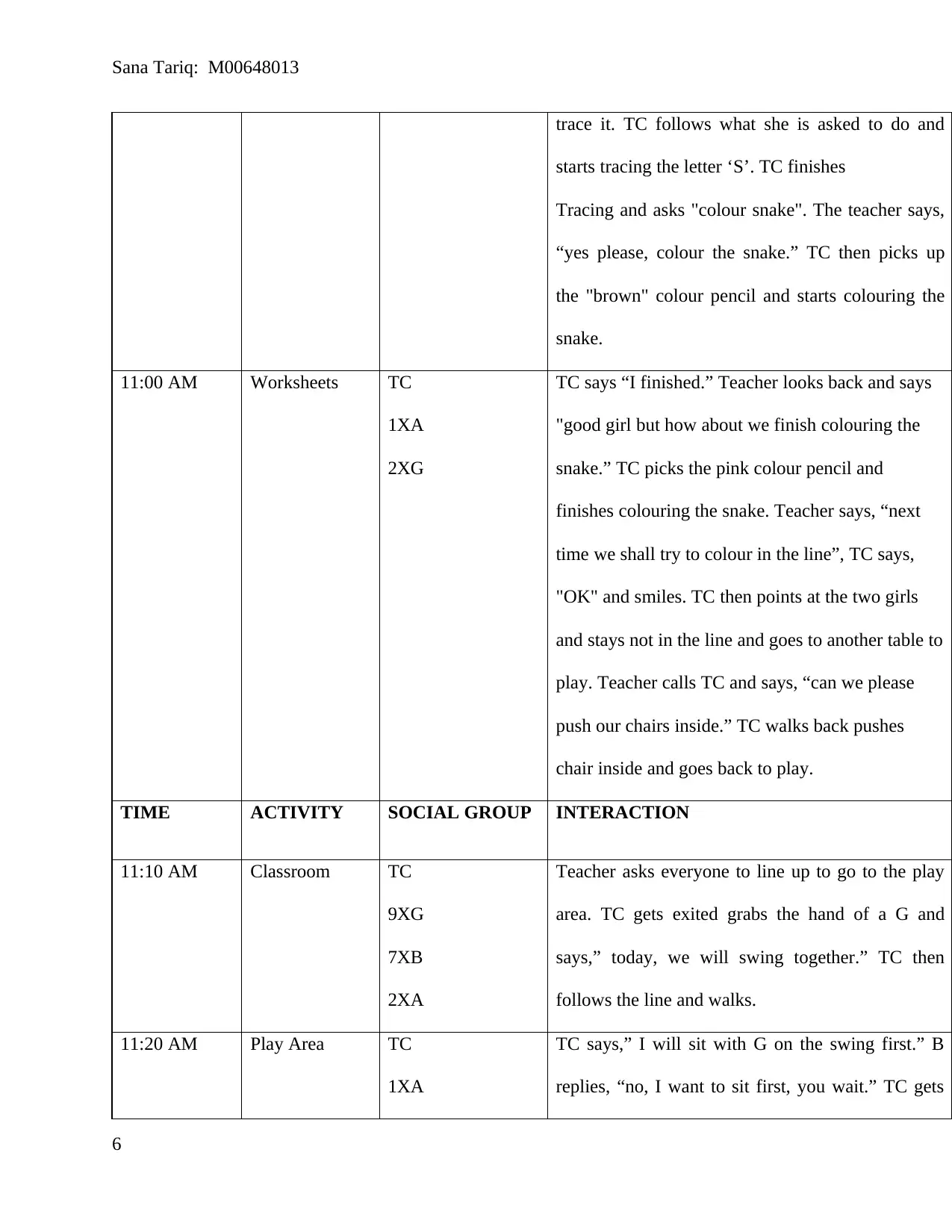
Sana Tariq: M00648013
trace it. TC follows what she is asked to do and
starts tracing the letter ‘S’. TC finishes
Tracing and asks "colour snake". The teacher says,
“yes please, colour the snake.” TC then picks up
the "brown" colour pencil and starts colouring the
snake.
11:00 AM Worksheets TC
1XA
2XG
TC says “I finished.” Teacher looks back and says
"good girl but how about we finish colouring the
snake.” TC picks the pink colour pencil and
finishes colouring the snake. Teacher says, “next
time we shall try to colour in the line”, TC says,
"OK" and smiles. TC then points at the two girls
and stays not in the line and goes to another table to
play. Teacher calls TC and says, “can we please
push our chairs inside.” TC walks back pushes
chair inside and goes back to play.
TIME ACTIVITY SOCIAL GROUP INTERACTION
11:10 AM Classroom TC
9XG
7XB
2XA
Teacher asks everyone to line up to go to the play
area. TC gets exited grabs the hand of a G and
says,” today, we will swing together.” TC then
follows the line and walks.
11:20 AM Play Area TC
1XA
TC says,” I will sit with G on the swing first.” B
replies, “no, I want to sit first, you wait.” TC gets
6
trace it. TC follows what she is asked to do and
starts tracing the letter ‘S’. TC finishes
Tracing and asks "colour snake". The teacher says,
“yes please, colour the snake.” TC then picks up
the "brown" colour pencil and starts colouring the
snake.
11:00 AM Worksheets TC
1XA
2XG
TC says “I finished.” Teacher looks back and says
"good girl but how about we finish colouring the
snake.” TC picks the pink colour pencil and
finishes colouring the snake. Teacher says, “next
time we shall try to colour in the line”, TC says,
"OK" and smiles. TC then points at the two girls
and stays not in the line and goes to another table to
play. Teacher calls TC and says, “can we please
push our chairs inside.” TC walks back pushes
chair inside and goes back to play.
TIME ACTIVITY SOCIAL GROUP INTERACTION
11:10 AM Classroom TC
9XG
7XB
2XA
Teacher asks everyone to line up to go to the play
area. TC gets exited grabs the hand of a G and
says,” today, we will swing together.” TC then
follows the line and walks.
11:20 AM Play Area TC
1XA
TC says,” I will sit with G on the swing first.” B
replies, “no, I want to sit first, you wait.” TC gets
6
⊘ This is a preview!⊘
Do you want full access?
Subscribe today to unlock all pages.

Trusted by 1+ million students worldwide
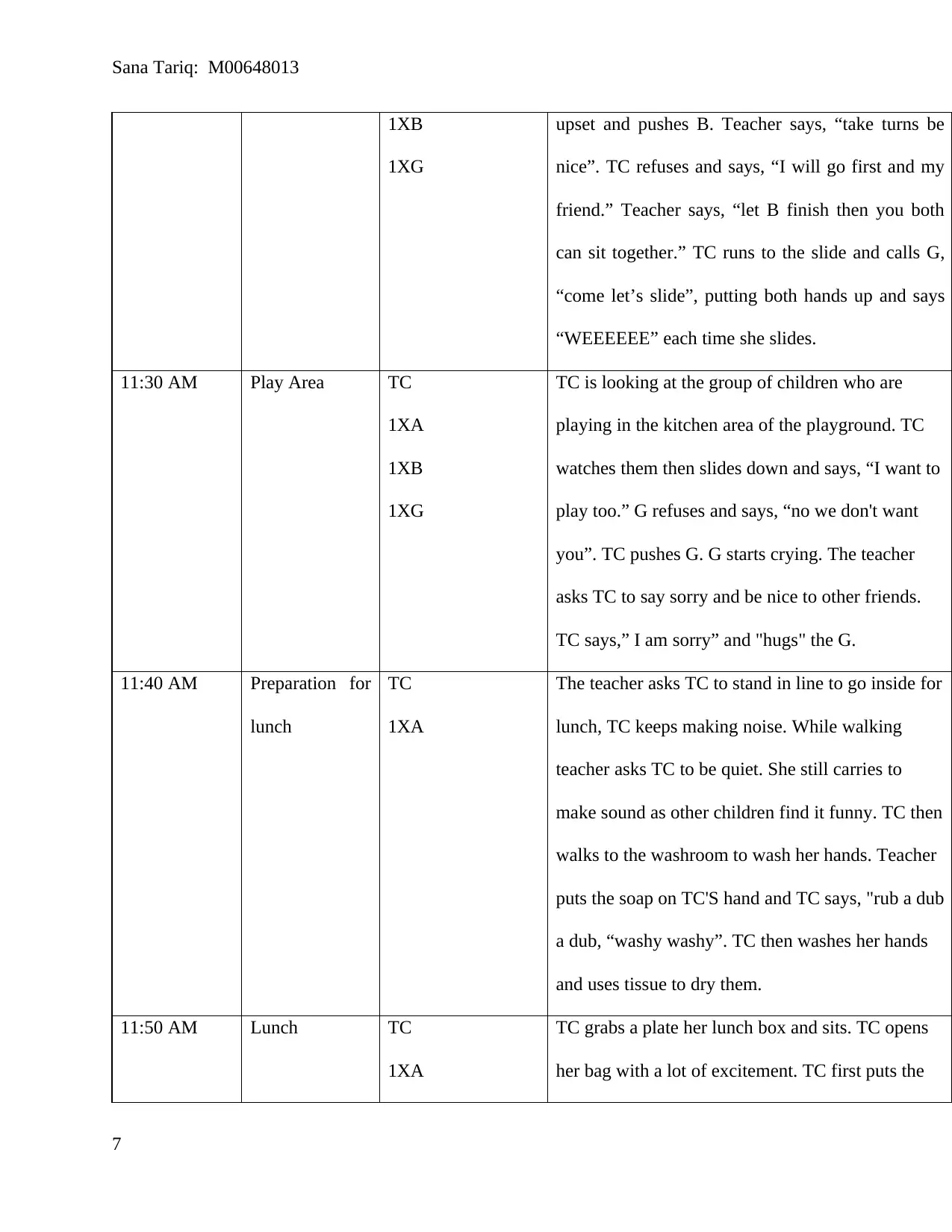
Sana Tariq: M00648013
1XB
1XG
upset and pushes B. Teacher says, “take turns be
nice”. TC refuses and says, “I will go first and my
friend.” Teacher says, “let B finish then you both
can sit together.” TC runs to the slide and calls G,
“come let’s slide”, putting both hands up and says
“WEEEEEE” each time she slides.
11:30 AM Play Area TC
1XA
1XB
1XG
TC is looking at the group of children who are
playing in the kitchen area of the playground. TC
watches them then slides down and says, “I want to
play too.” G refuses and says, “no we don't want
you”. TC pushes G. G starts crying. The teacher
asks TC to say sorry and be nice to other friends.
TC says,” I am sorry” and "hugs" the G.
11:40 AM Preparation for
lunch
TC
1XA
The teacher asks TC to stand in line to go inside for
lunch, TC keeps making noise. While walking
teacher asks TC to be quiet. She still carries to
make sound as other children find it funny. TC then
walks to the washroom to wash her hands. Teacher
puts the soap on TC'S hand and TC says, "rub a dub
a dub, “washy washy”. TC then washes her hands
and uses tissue to dry them.
11:50 AM Lunch TC
1XA
TC grabs a plate her lunch box and sits. TC opens
her bag with a lot of excitement. TC first puts the
7
1XB
1XG
upset and pushes B. Teacher says, “take turns be
nice”. TC refuses and says, “I will go first and my
friend.” Teacher says, “let B finish then you both
can sit together.” TC runs to the slide and calls G,
“come let’s slide”, putting both hands up and says
“WEEEEEE” each time she slides.
11:30 AM Play Area TC
1XA
1XB
1XG
TC is looking at the group of children who are
playing in the kitchen area of the playground. TC
watches them then slides down and says, “I want to
play too.” G refuses and says, “no we don't want
you”. TC pushes G. G starts crying. The teacher
asks TC to say sorry and be nice to other friends.
TC says,” I am sorry” and "hugs" the G.
11:40 AM Preparation for
lunch
TC
1XA
The teacher asks TC to stand in line to go inside for
lunch, TC keeps making noise. While walking
teacher asks TC to be quiet. She still carries to
make sound as other children find it funny. TC then
walks to the washroom to wash her hands. Teacher
puts the soap on TC'S hand and TC says, "rub a dub
a dub, “washy washy”. TC then washes her hands
and uses tissue to dry them.
11:50 AM Lunch TC
1XA
TC grabs a plate her lunch box and sits. TC opens
her bag with a lot of excitement. TC first puts the
7
Paraphrase This Document
Need a fresh take? Get an instant paraphrase of this document with our AI Paraphraser
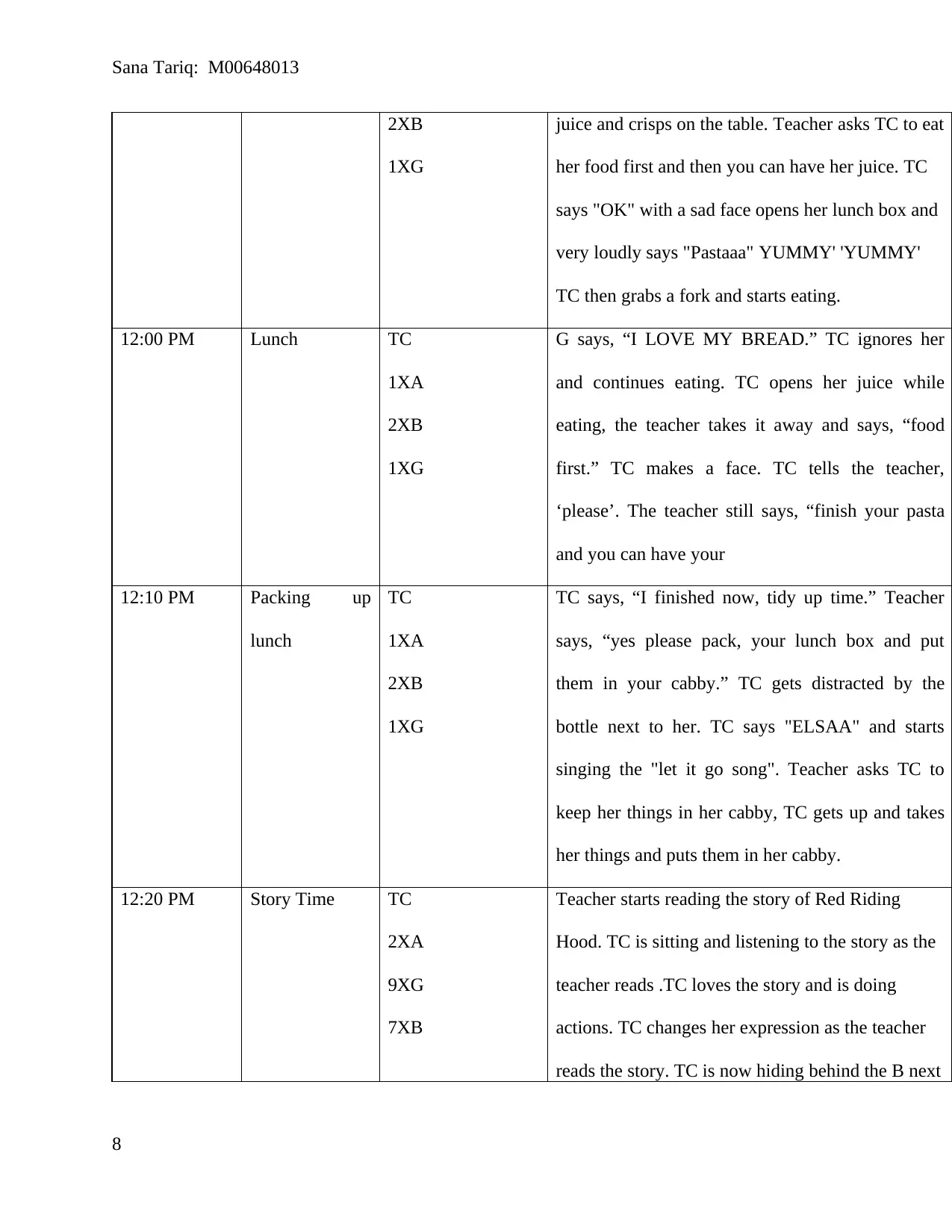
Sana Tariq: M00648013
2XB
1XG
juice and crisps on the table. Teacher asks TC to eat
her food first and then you can have her juice. TC
says "OK" with a sad face opens her lunch box and
very loudly says "Pastaaa" YUMMY' 'YUMMY'
TC then grabs a fork and starts eating.
12:00 PM Lunch TC
1XA
2XB
1XG
G says, “I LOVE MY BREAD.” TC ignores her
and continues eating. TC opens her juice while
eating, the teacher takes it away and says, “food
first.” TC makes a face. TC tells the teacher,
‘please’. The teacher still says, “finish your pasta
and you can have your
12:10 PM Packing up
lunch
TC
1XA
2XB
1XG
TC says, “I finished now, tidy up time.” Teacher
says, “yes please pack, your lunch box and put
them in your cabby.” TC gets distracted by the
bottle next to her. TC says "ELSAA" and starts
singing the "let it go song". Teacher asks TC to
keep her things in her cabby, TC gets up and takes
her things and puts them in her cabby.
12:20 PM Story Time TC
2XA
9XG
7XB
Teacher starts reading the story of Red Riding
Hood. TC is sitting and listening to the story as the
teacher reads .TC loves the story and is doing
actions. TC changes her expression as the teacher
reads the story. TC is now hiding behind the B next
8
2XB
1XG
juice and crisps on the table. Teacher asks TC to eat
her food first and then you can have her juice. TC
says "OK" with a sad face opens her lunch box and
very loudly says "Pastaaa" YUMMY' 'YUMMY'
TC then grabs a fork and starts eating.
12:00 PM Lunch TC
1XA
2XB
1XG
G says, “I LOVE MY BREAD.” TC ignores her
and continues eating. TC opens her juice while
eating, the teacher takes it away and says, “food
first.” TC makes a face. TC tells the teacher,
‘please’. The teacher still says, “finish your pasta
and you can have your
12:10 PM Packing up
lunch
TC
1XA
2XB
1XG
TC says, “I finished now, tidy up time.” Teacher
says, “yes please pack, your lunch box and put
them in your cabby.” TC gets distracted by the
bottle next to her. TC says "ELSAA" and starts
singing the "let it go song". Teacher asks TC to
keep her things in her cabby, TC gets up and takes
her things and puts them in her cabby.
12:20 PM Story Time TC
2XA
9XG
7XB
Teacher starts reading the story of Red Riding
Hood. TC is sitting and listening to the story as the
teacher reads .TC loves the story and is doing
actions. TC changes her expression as the teacher
reads the story. TC is now hiding behind the B next
8
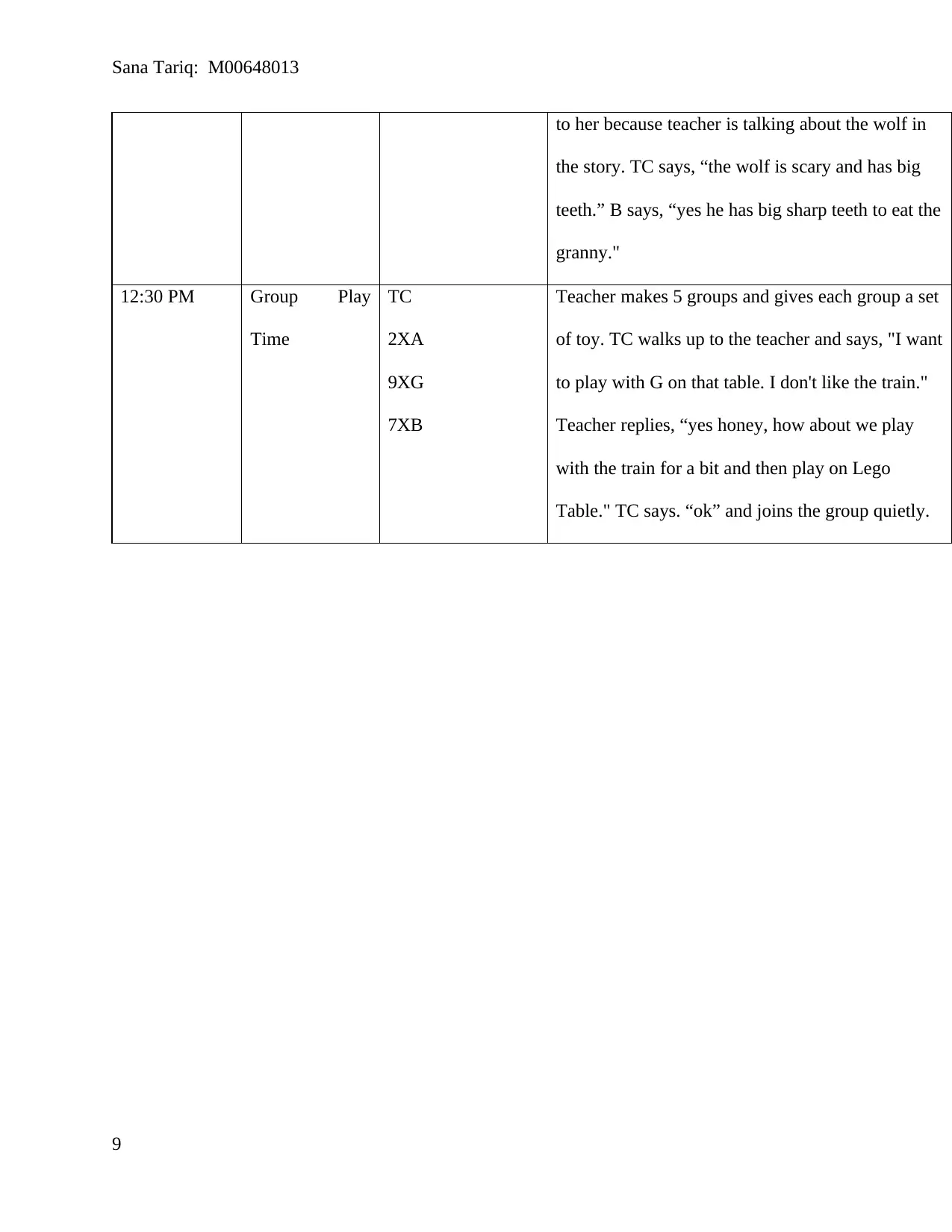
Sana Tariq: M00648013
to her because teacher is talking about the wolf in
the story. TC says, “the wolf is scary and has big
teeth.” B says, “yes he has big sharp teeth to eat the
granny."
12:30 PM Group Play
Time
TC
2XA
9XG
7XB
Teacher makes 5 groups and gives each group a set
of toy. TC walks up to the teacher and says, "I want
to play with G on that table. I don't like the train."
Teacher replies, “yes honey, how about we play
with the train for a bit and then play on Lego
Table." TC says. “ok” and joins the group quietly.
9
to her because teacher is talking about the wolf in
the story. TC says, “the wolf is scary and has big
teeth.” B says, “yes he has big sharp teeth to eat the
granny."
12:30 PM Group Play
Time
TC
2XA
9XG
7XB
Teacher makes 5 groups and gives each group a set
of toy. TC walks up to the teacher and says, "I want
to play with G on that table. I don't like the train."
Teacher replies, “yes honey, how about we play
with the train for a bit and then play on Lego
Table." TC says. “ok” and joins the group quietly.
9
⊘ This is a preview!⊘
Do you want full access?
Subscribe today to unlock all pages.

Trusted by 1+ million students worldwide
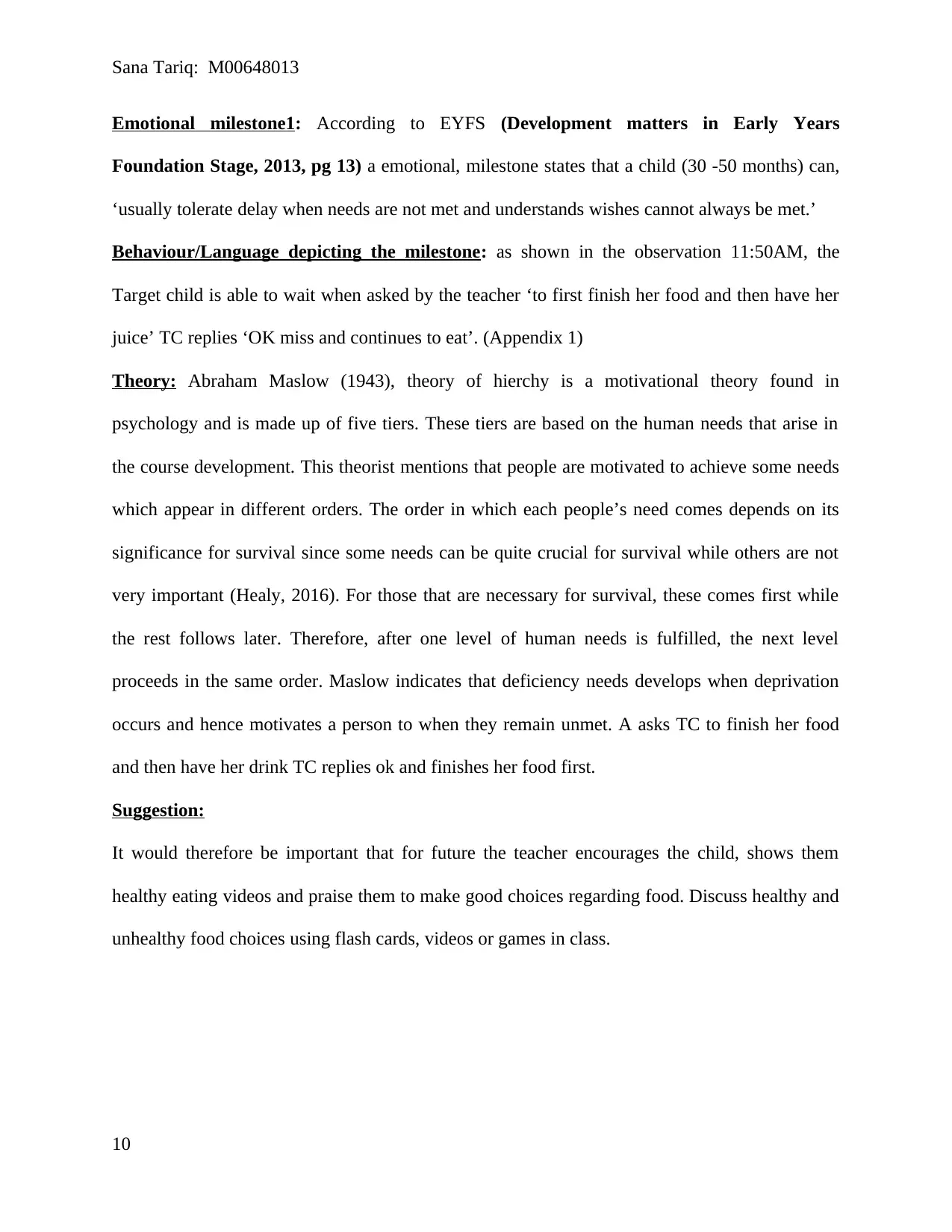
Sana Tariq: M00648013
Emotional milestone1: According to EYFS (Development matters in Early Years
Foundation Stage, 2013, pg 13) a emotional, milestone states that a child (30 -50 months) can,
‘usually tolerate delay when needs are not met and understands wishes cannot always be met.’
Behaviour/Language depicting the milestone: as shown in the observation 11:50AM, the
Target child is able to wait when asked by the teacher ‘to first finish her food and then have her
juice’ TC replies ‘OK miss and continues to eat’. (Appendix 1)
Theory: Abraham Maslow (1943), theory of hierchy is a motivational theory found in
psychology and is made up of five tiers. These tiers are based on the human needs that arise in
the course development. This theorist mentions that people are motivated to achieve some needs
which appear in different orders. The order in which each people’s need comes depends on its
significance for survival since some needs can be quite crucial for survival while others are not
very important (Healy, 2016). For those that are necessary for survival, these comes first while
the rest follows later. Therefore, after one level of human needs is fulfilled, the next level
proceeds in the same order. Maslow indicates that deficiency needs develops when deprivation
occurs and hence motivates a person to when they remain unmet. A asks TC to finish her food
and then have her drink TC replies ok and finishes her food first.
Suggestion:
It would therefore be important that for future the teacher encourages the child, shows them
healthy eating videos and praise them to make good choices regarding food. Discuss healthy and
unhealthy food choices using flash cards, videos or games in class.
10
Emotional milestone1: According to EYFS (Development matters in Early Years
Foundation Stage, 2013, pg 13) a emotional, milestone states that a child (30 -50 months) can,
‘usually tolerate delay when needs are not met and understands wishes cannot always be met.’
Behaviour/Language depicting the milestone: as shown in the observation 11:50AM, the
Target child is able to wait when asked by the teacher ‘to first finish her food and then have her
juice’ TC replies ‘OK miss and continues to eat’. (Appendix 1)
Theory: Abraham Maslow (1943), theory of hierchy is a motivational theory found in
psychology and is made up of five tiers. These tiers are based on the human needs that arise in
the course development. This theorist mentions that people are motivated to achieve some needs
which appear in different orders. The order in which each people’s need comes depends on its
significance for survival since some needs can be quite crucial for survival while others are not
very important (Healy, 2016). For those that are necessary for survival, these comes first while
the rest follows later. Therefore, after one level of human needs is fulfilled, the next level
proceeds in the same order. Maslow indicates that deficiency needs develops when deprivation
occurs and hence motivates a person to when they remain unmet. A asks TC to finish her food
and then have her drink TC replies ok and finishes her food first.
Suggestion:
It would therefore be important that for future the teacher encourages the child, shows them
healthy eating videos and praise them to make good choices regarding food. Discuss healthy and
unhealthy food choices using flash cards, videos or games in class.
10
Paraphrase This Document
Need a fresh take? Get an instant paraphrase of this document with our AI Paraphraser
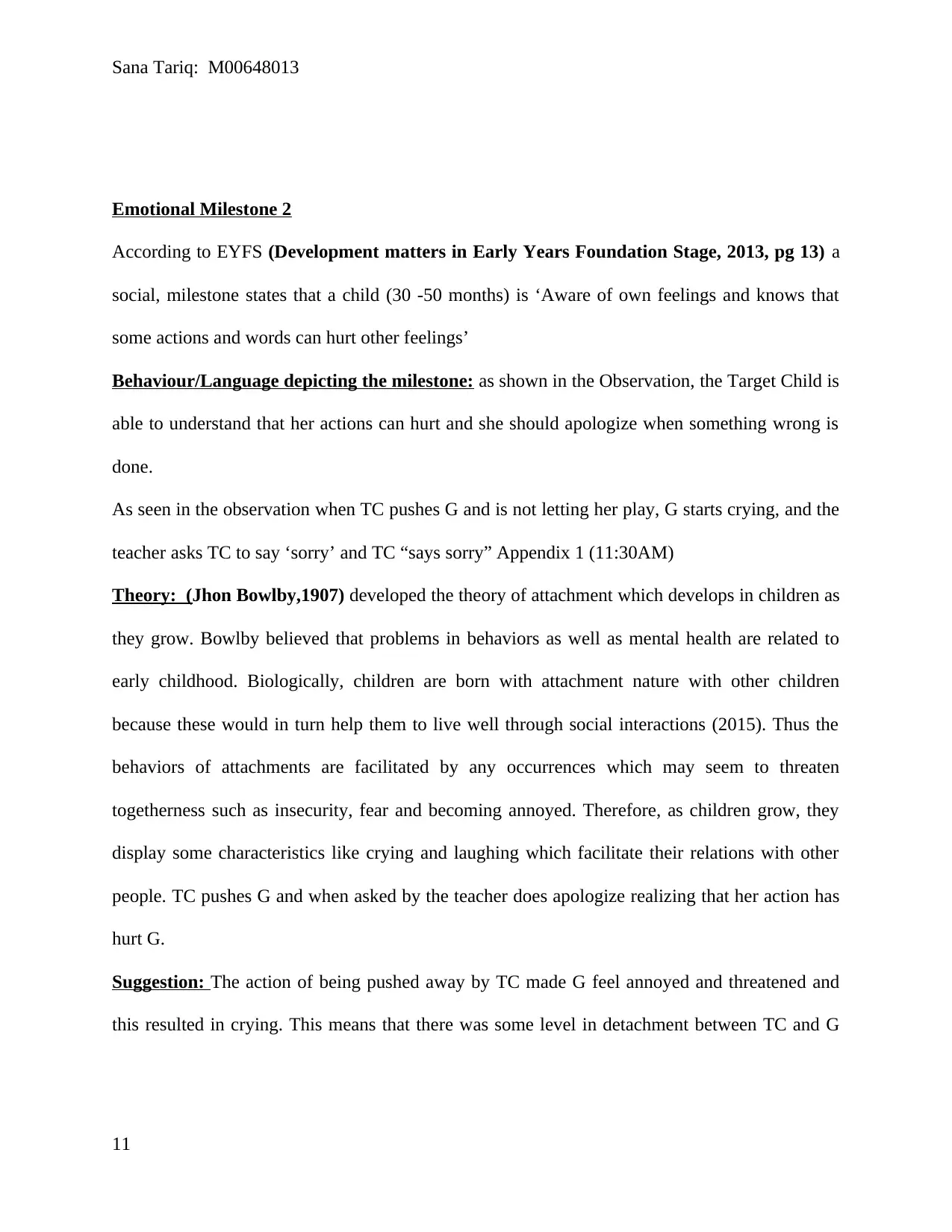
Sana Tariq: M00648013
Emotional Milestone 2
According to EYFS (Development matters in Early Years Foundation Stage, 2013, pg 13) a
social, milestone states that a child (30 -50 months) is ‘Aware of own feelings and knows that
some actions and words can hurt other feelings’
Behaviour/Language depicting the milestone: as shown in the Observation, the Target Child is
able to understand that her actions can hurt and she should apologize when something wrong is
done.
As seen in the observation when TC pushes G and is not letting her play, G starts crying, and the
teacher asks TC to say ‘sorry’ and TC “says sorry” Appendix 1 (11:30AM)
Theory: (Jhon Bowlby,1907) developed the theory of attachment which develops in children as
they grow. Bowlby believed that problems in behaviors as well as mental health are related to
early childhood. Biologically, children are born with attachment nature with other children
because these would in turn help them to live well through social interactions (2015). Thus the
behaviors of attachments are facilitated by any occurrences which may seem to threaten
togetherness such as insecurity, fear and becoming annoyed. Therefore, as children grow, they
display some characteristics like crying and laughing which facilitate their relations with other
people. TC pushes G and when asked by the teacher does apologize realizing that her action has
hurt G.
Suggestion: The action of being pushed away by TC made G feel annoyed and threatened and
this resulted in crying. This means that there was some level in detachment between TC and G
11
Emotional Milestone 2
According to EYFS (Development matters in Early Years Foundation Stage, 2013, pg 13) a
social, milestone states that a child (30 -50 months) is ‘Aware of own feelings and knows that
some actions and words can hurt other feelings’
Behaviour/Language depicting the milestone: as shown in the Observation, the Target Child is
able to understand that her actions can hurt and she should apologize when something wrong is
done.
As seen in the observation when TC pushes G and is not letting her play, G starts crying, and the
teacher asks TC to say ‘sorry’ and TC “says sorry” Appendix 1 (11:30AM)
Theory: (Jhon Bowlby,1907) developed the theory of attachment which develops in children as
they grow. Bowlby believed that problems in behaviors as well as mental health are related to
early childhood. Biologically, children are born with attachment nature with other children
because these would in turn help them to live well through social interactions (2015). Thus the
behaviors of attachments are facilitated by any occurrences which may seem to threaten
togetherness such as insecurity, fear and becoming annoyed. Therefore, as children grow, they
display some characteristics like crying and laughing which facilitate their relations with other
people. TC pushes G and when asked by the teacher does apologize realizing that her action has
hurt G.
Suggestion: The action of being pushed away by TC made G feel annoyed and threatened and
this resulted in crying. This means that there was some level in detachment between TC and G
11
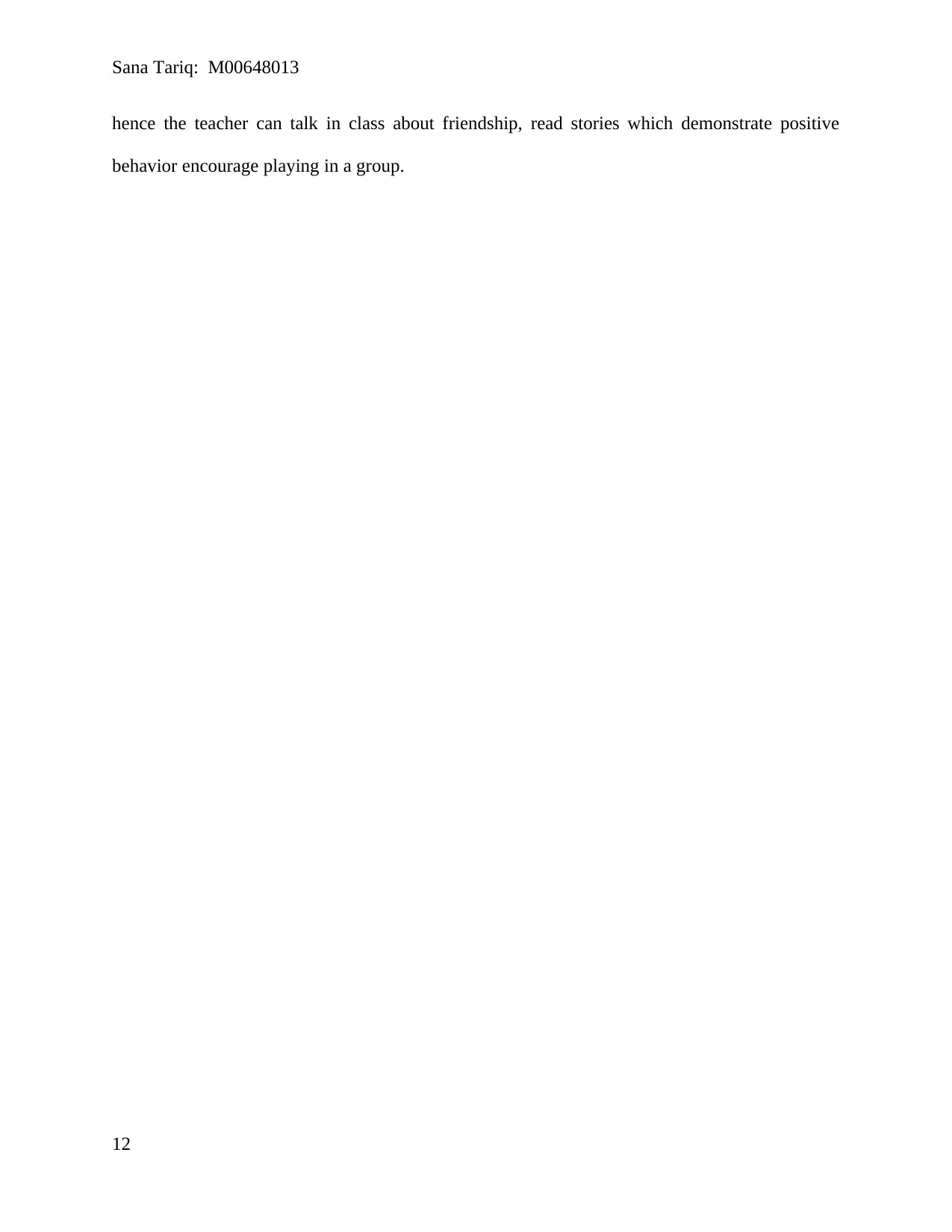
Sana Tariq: M00648013
hence the teacher can talk in class about friendship, read stories which demonstrate positive
behavior encourage playing in a group.
12
hence the teacher can talk in class about friendship, read stories which demonstrate positive
behavior encourage playing in a group.
12
⊘ This is a preview!⊘
Do you want full access?
Subscribe today to unlock all pages.

Trusted by 1+ million students worldwide
1 out of 33
Your All-in-One AI-Powered Toolkit for Academic Success.
+13062052269
info@desklib.com
Available 24*7 on WhatsApp / Email
![[object Object]](/_next/static/media/star-bottom.7253800d.svg)
Unlock your academic potential
Copyright © 2020–2025 A2Z Services. All Rights Reserved. Developed and managed by ZUCOL.
